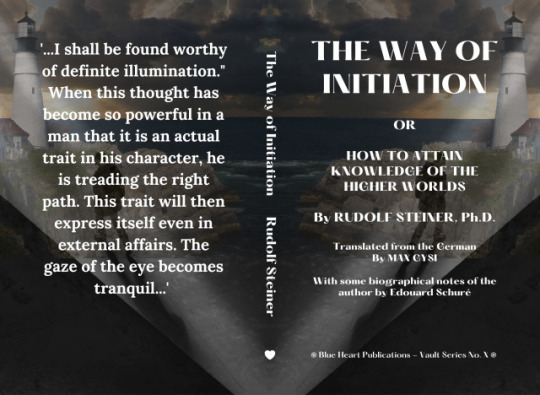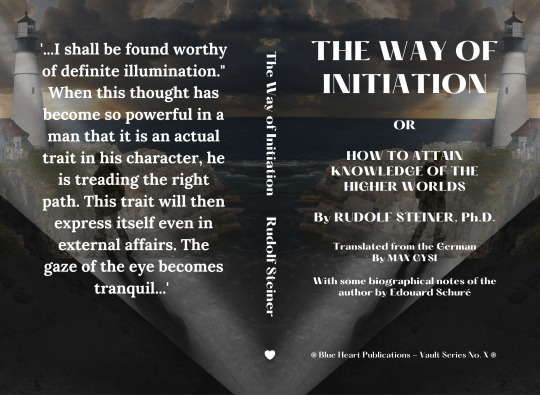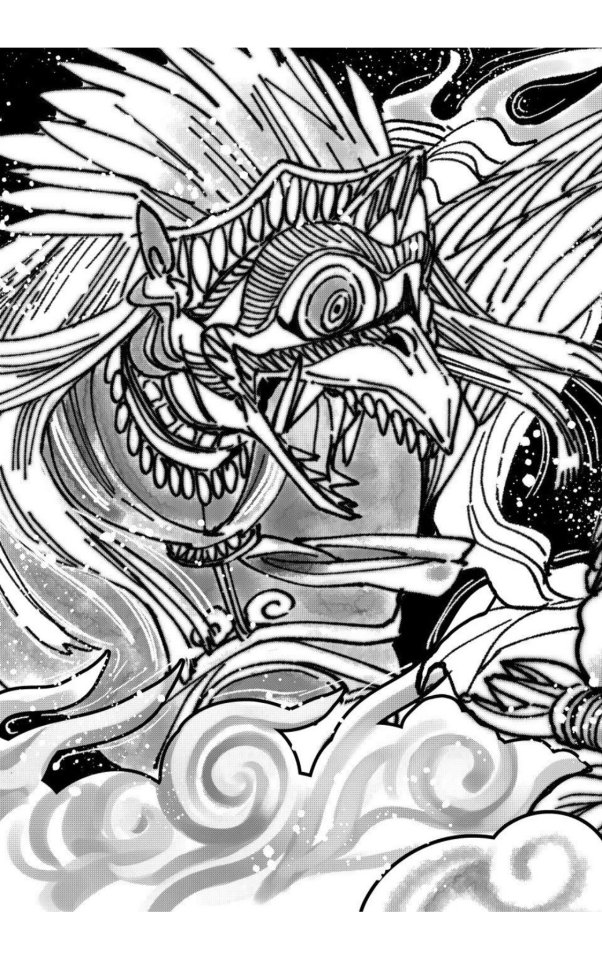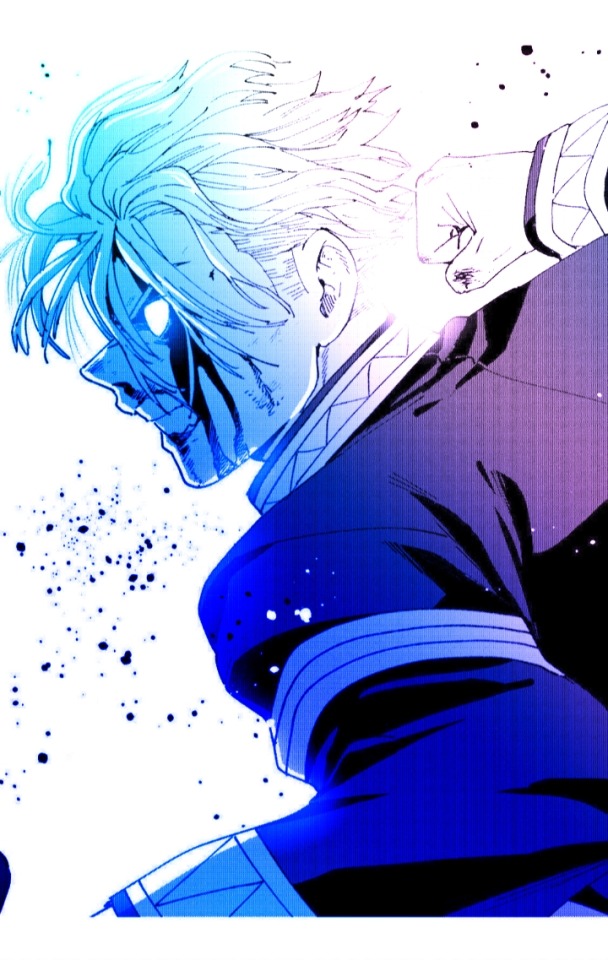#Transcendental Wisdom
Explore tagged Tumblr posts
Text

The Prajnaparamita Statue from East Java is perhaps the most famous image of the goddess of transcendental wisdom.
5 notes
·
View notes
Text
The Paradox of Creation and Spiritual Enlightenment
In the realm of existence, there lies a profound mystery: the relationship between a creation and its creator. This enigma is deeply rooted in the concept of spiritual enlightenment, a state of awakening to a higher understanding beyond the tangible and the temporal.Consider this: everything within our grasp, every entity, every idea, has a beginning and an end. This cycle of birth and cessation…

View On WordPress
#awakening#Creator-Creation Paradox#Existential Mystery#Philosophical Insights#spiritual enlightenment#Transcendental Wisdom#Unknown Realms
6 notes
·
View notes
Text
"Embarking on the Enlightened Journey: A Profound Exploration of 'The Way of Initiation' by Rudolf Steiner"

In "The Way of Initiation: How to Attain Knowledge of the Higher Worlds," Rudolf Steiner invites readers on an extraordinary journey into the realms of spiritual enlightenment. Steeped in mysticism, this captivating exploration serves as a profound guide for those seeking a deeper understanding of the higher dimensions of existence.
The book's allure lies in Steiner's ability to seamlessly weave esoteric knowledge with practical guidance. He presents a roadmap for spiritual seekers, detailing the intricate process of initiation into the mysteries of the higher worlds. Steiner masterfully combines philosophy, mysticism, and spirituality, creating a tapestry that resonates with both the curious and the seasoned seeker.
One of the book's strengths is Steiner's emphasis on personal experience. He encourages readers to embark on their spiritual quest actively, providing practical exercises and meditations to facilitate a direct connection with the higher realms. This hands-on approach distinguishes "The Way of Initiation" from mere theoretical discourse, making it a valuable companion for those eager to delve into the mystical unknown.
Steiner's prose is both eloquent and accessible, demystifying complex spiritual concepts without diminishing their profundity. The narrative unfolds like a sacred scroll, gradually revealing the secrets of the universe and the soul's journey towards enlightenment. Each chapter serves as a stepping stone, guiding the reader through cosmic truths and unveiling the interconnectedness of the spiritual and material worlds.
The book delves into various esoteric topics, including the development of higher faculties, encounters with spiritual beings, and the transformative power of inner alchemy. Steiner's insights, drawn from a deep well of wisdom, shed light on the significance of inner growth and the evolution of human consciousness.
As a visionary thinker, Steiner acknowledges the challenges of spiritual exploration and provides pragmatic advice for navigating potential pitfalls. His holistic approach encompasses the integration of spiritual wisdom into daily life, fostering a harmonious balance between the mystical and the mundane.
In conclusion, "The Way of Initiation" stands as a timeless beacon illuminating the path to spiritual enlightenment. Steiner's eloquent prose, coupled with practical exercises, creates an immersive experience for readers. Whether you are a novice seeking to unlock the mysteries of the cosmos or a seasoned explorer of spiritual realms, Steiner's work offers profound insights that resonate across the ages. Embark on this transformative journey, and let the wisdom within these pages awaken the seeker within.
"The Way of Initiation: How to Attain Knowledge of the Higher Worlds," by Rudolf Steiner is available in Amazon in paperback 11.99$ and hardcover 19.99$ editions.
Number of pages: 186
Language: English
Rating: 9/10
Link of the book!
Review By: King's Cat
#Rudolf Steiner#Esoteric Wisdom#Spiritual Awakening#Higher Knowledge#Mystic Philosophy#Inner Transformation#Self-Realization#Initiation#Meditation Practices#Mystical Journeys#Path to Enlightenment#Higher Worlds#Transcendental Wisdom#Spiritual Perception#Metaphysical Exploration#Practical Spirituality#Conscious Evolution#Theosophy#Occult Wisdom#Divine Consciousness#Mystical Realms#Inner Alchemy#Moral Development#Self-Discipline#Inner Wisdom#Transcendental Experience#Mystic Insights#Higher Self#Spiritual Growth#Cosmic Knowledge
6 notes
·
View notes
Text
"Embarking on the Enlightened Journey: A Profound Exploration of 'The Way of Initiation' by Rudolf Steiner"

In "The Way of Initiation: How to Attain Knowledge of the Higher Worlds," Rudolf Steiner invites readers on an extraordinary journey into the realms of spiritual enlightenment. Steeped in mysticism, this captivating exploration serves as a profound guide for those seeking a deeper understanding of the higher dimensions of existence.
The book's allure lies in Steiner's ability to seamlessly weave esoteric knowledge with practical guidance. He presents a roadmap for spiritual seekers, detailing the intricate process of initiation into the mysteries of the higher worlds. Steiner masterfully combines philosophy, mysticism, and spirituality, creating a tapestry that resonates with both the curious and the seasoned seeker.
One of the book's strengths is Steiner's emphasis on personal experience. He encourages readers to embark on their spiritual quest actively, providing practical exercises and meditations to facilitate a direct connection with the higher realms. This hands-on approach distinguishes "The Way of Initiation" from mere theoretical discourse, making it a valuable companion for those eager to delve into the mystical unknown.
Steiner's prose is both eloquent and accessible, demystifying complex spiritual concepts without diminishing their profundity. The narrative unfolds like a sacred scroll, gradually revealing the secrets of the universe and the soul's journey towards enlightenment. Each chapter serves as a stepping stone, guiding the reader through cosmic truths and unveiling the interconnectedness of the spiritual and material worlds.
The book delves into various esoteric topics, including the development of higher faculties, encounters with spiritual beings, and the transformative power of inner alchemy. Steiner's insights, drawn from a deep well of wisdom, shed light on the significance of inner growth and the evolution of human consciousness.
As a visionary thinker, Steiner acknowledges the challenges of spiritual exploration and provides pragmatic advice for navigating potential pitfalls. His holistic approach encompasses the integration of spiritual wisdom into daily life, fostering a harmonious balance between the mystical and the mundane.
In conclusion, "The Way of Initiation" stands as a timeless beacon illuminating the path to spiritual enlightenment. Steiner's eloquent prose, coupled with practical exercises, creates an immersive experience for readers. Whether you are a novice seeking to unlock the mysteries of the cosmos or a seasoned explorer of spiritual realms, Steiner's work offers profound insights that resonate across the ages. Embark on this transformative journey, and let the wisdom within these pages awaken the seeker within.
"The Way of Initiation: How to Attain Knowledge of the Higher Worlds," by Rudolf Steiner is available in Amazon in paperback 11.99$ and hardcover 19.99$ editions.
Number of pages: 186
Language: English
Rating: 9/10
Link of the book!
Review By: King's Cat
#Rudolf Steiner#Esoteric Wisdom#Spiritual Awakening#Higher Knowledge#Mystic Philosophy#Inner Transformation#Self-Realization#Initiation#Meditation Practices#Mystical Journeys#Path to Enlightenment#Higher Worlds#Transcendental Wisdom#Spiritual Perception#Metaphysical Exploration#Practical Spirituality#Conscious Evolution#Theosophy#Occult Wisdom#Divine Consciousness#Mystical Realms#Inner Alchemy#Moral Development#Self-Discipline#Inner Wisdom#Transcendental Experience#Mystic Insights#Higher Self#Spiritual Growth#Cosmic Knowledge
0 notes
Text
"Do not go where the path may lead, go instead where there is no path and leave a trail." – Ralph Waldo Emerson
#inspiration#emerson#trailblazer#individuality#motivational quotes#creativity#unique path#forge your way#courage#self-discovery#transcendentalism#timeless wisdom#personal growth#making a difference#innovation#independence#adventurous spirit#break the mold#visionary#live boldly#inspiring thoughts#leadership#inspirational figures#literary quotes#self-reliance#words to live by#courage and strength#daily motivation#transcendentalist wisdom#transformation
10 notes
·
View notes
Text
Hi folks, this blog is a space for exploring philosophy and spirituality with intellectual honesty. It will also include essays and threads from a neopagan, antimonist (pro-pluralistic) perspective including UPG (unverified personal gnosis) testimony.
Just like the "paradox of tolerance", we must reject monotheistic and supremacist claims in spirituality to achieve this goal. Love and peace to all, go in Sophia's Grace.
#paganblr#heathen#heathenry#paganism#pagan#wisdom#discourse#religion#spirituality#philosophy#transcendentalism#gnosis#thelema#queer spirituality
7 notes
·
View notes
Text

#George Harrison#The Beatles#Words of wisdom#Spiritual awakening#Transcendental#Self Realization#Hippies#Hare Krishna
2 notes
·
View notes
Text
Great meaning to ancient truth
Siva In Tantra
Q: What Is Siva In Tantra? A: In Tantra Mystic Phonemes Of Sanskrit rules श = Mahāmāyā व = Māyā इ = Highest Intent Power Of Transcendental. So Siva In Tantra Is Supreme Transcendental beyond all, beyond Supreme Consciousness. Shiva predates Veda - Dr Devang H Dattani
Good Morning
Quote / Poem / Poetry / Quotes Of
Bhagwan Sri Sri Sri
Doctor Devang H Dattani
Infinite SriSriSri DDD
Posted By TheBlissCity DDD Team
See The Media Photo Video For
Quoteoftheday
God Morning
#lotus , #bliss , #TheBlissCity , #philosophy , #mindfulness , #DrDevangHDattani , #nature , #awareness , #InfiniteSriSriSriDDD , #quotes , #life , #art , #zen , #awakening , #quote , #spiritual , #photography , #Video , #meditation , #psychology , #poem , #poetry , #motivation , #inspiration , #quoteoftheday , #love , #words , #thoughts , #joy , #pun , #enlightenment , #health , #mental health , #consciousness , #truth , #god , #landscape , #life , #video , #awakening , #lake , #flower , #blossom , #nirvana , #tantra , #yoga , #lotuses , #flowers , #blossoming , #funny , #videography , #photooftheday , #kindness , #happiness , #mother , #child , #birth
#tantric#artists on tumblr#skyscape#tantra#nature photography#lord shiva#siva#shiva#beautiful quote#lord#TheBlissCity#DrDevangHDattani#InfiniteSriSriSriDDD#spilled ink#wisdom#words#transcendentalism#photographers on tumblr#the book of bill#phonemes#writers on tumblr#spilled words#motivating quotes#inspiring quotes#questions#answered#consciousness#esoteric#hinduism#philosophy quotes
48 notes
·
View notes
Text

"To the Kabbalist, the ultimate paradise is here now, because the Infinite Light is here now.
The focus of Kabbalah is not on serenity. Neither is it on transcendental enlightenment. It provides those as well, but as a means, not as a goal. The goal of Kabbalah is inspired action. Whatever wisdom the Kabbalist gains, whatever state of ecstasy or mystic union to which he or she ascends, the end result will always be an act of beauty in the physical world."
~ Rabbi Tzvi Freeman
#kabbalah#enlightenment#heaven#consciousness#light#energy#magic#quotes#alchemy#esoteric#spiritual awakening#spirit#kundalini
279 notes
·
View notes
Text
Unveiling the African Essence in Eastern Philosophy
A Tribute during Black History MonthAs we embark on the celebration of Black History Month, it’s essential to recognize the myriad contributions of African descendants not just in shaping modern civilization but also in sculpting the contours of Eastern philosophy. The historical interweaving of African traditions with Eastern thought offers a rich narrative, highlighting a profound exchange of…

View On WordPress
#African influence#ancestral wisdom#ancient Egypt#Black History Month#Eastern Philosophy#Greek philosophy#Interconnectedness#nonduality#spiritual synergy#Transcendental Meditation#Ubuntu#Yoruba
10 notes
·
View notes
Text
"The Divine Pymander: Navigating the Cosmic Mysteries of Hermes Mercurius Trismegistus"

"The Divine Pymander" is a timeless masterpiece that delves into the profound depths of spirituality, mysticism, and the nature of existence. Penned by the legendary Hermes Mercurius Trismegistus, this enigmatic work continues to captivate readers across centuries, offering insights that transcend the boundaries of time and space.
The book comprises a series of dialogues between Hermes, the wise sage, and the divine entity known as Pymander. It unfolds as a spiritual journey, inviting readers to explore the hidden realms of the universe, the human soul, and the interconnectedness of all things. Hermes serves as both a guide and a seeker of wisdom, and through his conversations with Pymander, he unveils the secrets of the cosmos.
One of the central themes of "The Divine Pymander" is the concept of divine revelation and enlightenment. Hermes Mercurius Trismegistus imparts profound wisdom about the nature of God, the universe, and the human soul. He emphasizes the idea that true knowledge and spiritual awakening are attainable through direct communion with the divine. The book encourages readers to seek the inner light and transcend the limitations of the material world.
Throughout the text, Hermes expounds upon various metaphysical concepts, such as the Hermetic principles of correspondence, vibration, and polarity. These principles are presented as the keys to understanding the universe's hidden laws and the interconnectedness of all things. The book encourages readers to contemplate these principles and apply them to their lives, fostering personal growth and spiritual evolution.
"The Divine Pymander" also touches upon the idea of ascension, wherein the soul strives to return to its divine origin. Hermes outlines the transformative journey of the soul as it sheds its earthly attachments and ascends toward unity with the divine source. This theme resonates with readers seeking a deeper understanding of their spiritual path and purpose in life.
Hermes Mercurius Trismegistus' writing style is both poetic and philosophical, creating an atmosphere of mysticism and wonder. The text is rich in symbolism and allegory, inviting readers to interpret its teachings on multiple levels. While some passages may appear cryptic, they encourage introspection and personal reflection, allowing each reader to uncover their unique insights.
In conclusion, "The Divine Pymander" by Hermes Mercurius Trismegistus is a profound and illuminating work that continues to inspire seekers of spiritual truth and wisdom. Its timeless teachings on the nature of God, the universe, and the human soul provide a roadmap for those on a quest for higher knowledge and enlightenment. This book serves as a testament to the enduring power of ancient wisdom and the eternal quest for understanding the mysteries of existence.
"The Divine Pymander" of Hermes Mercurius Trismegistus is available in Amazon in paperback 12.99$ and hardcover 19.99$ editions.
Length of the book: 204 pages
Language: English
Rating: ∞/10
Link of the Book!
#Hermes Mercurius Trismegistus#The Divine Pymander#Hermeticism#Ancient Wisdom#Esoteric Knowledge#Spiritual Enlightenment#Alchemy#Gnostic Teachings#Cosmic Consciousness#Mystical Philosophy#Transcendental Wisdom#Universal Truths#Divine Revelations#Soul Transformation#Spiritual Alchemy#Hermetic Philosophy#Inner Enlightenment#Theurgy#Ancient Texts#Esoteric Traditions
0 notes
Text
"The Divine Pymander: Navigating the Cosmic Mysteries of Hermes Mercurius Trismegistus"

"The Divine Pymander" is a timeless masterpiece that delves into the profound depths of spirituality, mysticism, and the nature of existence. Penned by the legendary Hermes Mercurius Trismegistus, this enigmatic work continues to captivate readers across centuries, offering insights that transcend the boundaries of time and space.
The book comprises a series of dialogues between Hermes, the wise sage, and the divine entity known as Pymander. It unfolds as a spiritual journey, inviting readers to explore the hidden realms of the universe, the human soul, and the interconnectedness of all things. Hermes serves as both a guide and a seeker of wisdom, and through his conversations with Pymander, he unveils the secrets of the cosmos.
One of the central themes of "The Divine Pymander" is the concept of divine revelation and enlightenment. Hermes Mercurius Trismegistus imparts profound wisdom about the nature of God, the universe, and the human soul. He emphasizes the idea that true knowledge and spiritual awakening are attainable through direct communion with the divine. The book encourages readers to seek the inner light and transcend the limitations of the material world.
Throughout the text, Hermes expounds upon various metaphysical concepts, such as the Hermetic principles of correspondence, vibration, and polarity. These principles are presented as the keys to understanding the universe's hidden laws and the interconnectedness of all things. The book encourages readers to contemplate these principles and apply them to their lives, fostering personal growth and spiritual evolution.
"The Divine Pymander" also touches upon the idea of ascension, wherein the soul strives to return to its divine origin. Hermes outlines the transformative journey of the soul as it sheds its earthly attachments and ascends toward unity with the divine source. This theme resonates with readers seeking a deeper understanding of their spiritual path and purpose in life.
Hermes Mercurius Trismegistus' writing style is both poetic and philosophical, creating an atmosphere of mysticism and wonder. The text is rich in symbolism and allegory, inviting readers to interpret its teachings on multiple levels. While some passages may appear cryptic, they encourage introspection and personal reflection, allowing each reader to uncover their unique insights.
In conclusion, "The Divine Pymander" by Hermes Mercurius Trismegistus is a profound and illuminating work that continues to inspire seekers of spiritual truth and wisdom. Its timeless teachings on the nature of God, the universe, and the human soul provide a roadmap for those on a quest for higher knowledge and enlightenment. This book serves as a testament to the enduring power of ancient wisdom and the eternal quest for understanding the mysteries of existence.
"The Divine Pymander" of Hermes Mercurius Trismegistus is available in Amazon in paperback 12.99$ and hardcover 19.99$ editions.
Length of the book: 204 pages
Language: English
Rating: ∞/10
Link of the Book!
Review By: King's Cat
#Hermes Mercurius Trismegistus#The Divine Pymander#Hermeticism#Ancient Wisdom#Esoteric Knowledge#Spiritual Enlightenment#Alchemy#Gnostic Teachings#Cosmic Consciousness#Mystical Philosophy#Transcendental Wisdom#Universal Truths#Divine Revelations#Soul Transformation#Spiritual Alchemy#Hermetic Philosophy#Inner Enlightenment#Theurgy#Ancient Texts#Esoteric Traditions
1 note
·
View note
Text
"What lies behind us and what lies before us are tiny matters compared to what lies within us." – Ralph Waldo Emerson
#emerson#transcendentalism#inspiration#self-discovery#personal growth#life lessons#inner strength#timeless wisdom#spiritual growth#motivational quotes#courage#words to live by#iconic quotes#determination#self-awareness#creativity#visionary thinking#overcoming challenges#inner peace#transformative ideas#achieving greatness#positivity#resilience#mindfulness#courage and strength#personal strength#simplicity#wisdom of the ages#eastern philosophy#transcendence
5 notes
·
View notes
Text
Here's the discussion for Umemiya's deity representation as seen in the latest chapter. If you haven't seen my thoughts on Takiishi's yet then I've provided a link to that post as well.
(I hope you appreciate the better quality & organization of the post from my well-rested brain cells)
Part 1: Takiishi Chika and the Karura
Spoilers for Chapter 150!




In my last post, I discussed my theory that the bird-like deity depicted for Takiishi was a karura. With Umemiya, I believe the deity to be Fudō Myō-ō (不動明王, ふどうみょうおう) who is also known as the Immovable Wisdom King (Skt. Ācalanātha).


[Fudō Mask was sourced from the Japanese Buddhist Statuary: A to Z Phot Dictionary; (Wooden) Seated Fudō Myō-ō Statue by Kaikei created in 1203 sourced from Isumu (360° view available)]
Fudō Myō-ō is THE central deity among all of the Myō-ō (warlike or wrathful gods) groupings, but is most prominently featured among the Godai Myō-ō (五大明王, Five Great Kings) who are manifestations of the Five Transcendental Buddha. He was given the title as the Immovable One due to his unwaivering commitment to the protection of Buddhist teachings.
Orginating as a pagan deity from India, Fudō's conversion to Buddhism began with humble beginnings. He was assigned as a servant and messenger of Buddha himself and later achieving higher positions—becoming a manifestation of the power and virtues of Dainichi Buddha, one of the 5 Transcendental Buddha I mentioned previously. (Source: MetMuseum)
In regards to their appearances, Fudō shares a remarkable resemblance to the deity depicted in Chapter 150. From his adornments, eyebrows, hair style, the prominent scowl etched into their faces and the long side braid (?) to the left of the face.
Aside from looks, let's talk about the prominent parallels between Umemiya and Fudō Myō-ō:
Origins. Both Ume and Fudō had to start over with their lives, with Ume losing his family due to a car accident and Fudō being stripped of his former godhood after converting to Buddhism. Despite these, they were able to work their way up so they'll be strong enough to protect what they valued the most.
Their roles. According to Schumacher in his page about Fudō,
"Fudō converts anger into salvation..."
- Schumacher, M., "Fudō Myō-ō"
"converts anger into salvation", that seems familiar- Oh wait.




Fudō and Ume are guides to enlightenment AND protectors. They themselves are symbols of safety in the eyes of those under their care.
Connections. While the Godai Myō-ō (Five Great Kings) aren't closely related to the Shitennō (Four Heavenly Kings) as the former rank far above the latter, there are similarities to be found. One is that both groups are in charge of the five directions, and yes five. The Shitennō is commanded by Taishakuten (帝釈天) who is the Lord of the Center. Relating this back to Ume and his Four Kings, it's interesting to note that the mangaka choose a higher ranking god to represent Ume rather than use Taishakuten. Perhaps to differentiate the power gap between Umemiya and his Four Kings?
Conclusion: I'm confident that Fudō Myō-ō is definitely the god representing Umemiya with the evidence I have gathered as well as several others have come to similar conclusions to the fact. It was really fun deep diving into this research for both Takiishi and Umemiya and with a clear head than the previous post, perhaps I'd like to make another one but of Tomiyama and Togame (The Hare & The Tortoise) or Sakura and Sugshita (The Tiger & The Dragon). No promises though.
(P.S. I am not Japanese but I have been deeply interested in the culture and history. I do my best to use credible sources (both ENG and JPN) and give credit accordingly. However, I'm prone to slip ups so if there is anything that requires correction, notify me throught the post via reply/reblog.)
(P.S.S. I have a blog specifically made for wbk content for further post like this so feel free to visit me there @transient-winds )
#OKAY ITS DONE#*dies promptly*#see what happens when im not running on no sleep & food#umemiya the man u are#i understand the appeal tsubakino#wind breaker#wind breaker nii satoru#wind breaker chapter 150#umemiya hajime#hajime umemiya#takiishi chika#chika takiishi#umemiya vs takiishi fight
54 notes
·
View notes
Text


The Caduceus: Hermes Symbol of Harmony and Awakening
Hermes and the Caduceus
The Caduceus is primarily associated with Hermes Trismegistus, the Greek god known for being a messenger, guide of souls, and protector of merchants, shepherds, gamblers, liars, and thieves.
The symbol consists of a short rod entwined by two serpents and topped with a pair of wings, embodying the diverse and dynamic attributes of Hermes.
According to myth, the Caduceus originated in a specific episode involving Hermes.
One day, while traveling, Hermes came across two serpents entangled in a violent conflict. The serpents, locked in battle, were a symbol of discord and chaos. Observing their strife, Hermes sought to bring peace between them.
With a simple, yet profound gesture, he threw his rod between them as a mediator would step into a conflict.
The serpents, rather than continuing their fight, wrapped themselves around the rod in a double helix formation and their fighting ceased.
This act not only separated them but transformed their aggression into a dynamic balance, creating a new symbol of harmony and equilibrium.
The wings at the top of the rod signify the divine nature of the intervention and the elevation of the solution from earthly disputes to heavenly peace.
This transformative moment in mythology conveys deep symbolic meanings.
The serpents, traditionally symbols of wisdom, renewal, and healing due to their ability to shed their skin and renew themselves, here represent the dual forces of nature and life.
Their harmonious entanglement around the rod, which itself symbolizes authority and control, visually captures the balance between these forces.
This depiction illustrates the principle that through wise intervention and diplomatic action, balance and harmony can be achieved, transforming destructive energy into a constructive outcome.
The Caduceus carries layers of symbolism that delve into the nature of duality, healing, and transformation.
The two serpents coiled around a central staff encapsulate a visual depiction of balance and union of opposites, a theme prevalent in many philosophical and spiritual teachings.
Integration of Opposing Forces
The dual serpents of the Caduceus, spiraling around the central staff, visually signify the integration of opposing forces, a concept pivotal in many philosophical systems.
This integration is not merely a passive coexistence but an active unification that leads to greater wholeness and stability.
In many cultures, serpents are seen as embodying opposites — being both earth-bound and capable of transcendental knowledge.
Their union around the staff symbolizes the potential for reconciling such differences to foster unity and peace.
Symbol of Mediation and Peace
Hermes, wielding the Caduceus, guides the chaotic forces represented by the serpents towards reconciliation and unity.
Thus, the Caduceus symbolizes the transformation of conflict into peace and order, embodying the potential for wise intervention to harmonize opposing forces.
This portrayal of Hermes as a divine mediator illustrates how the Caduceus serves as a powerful emblem of peace, skillfully bridging gaps and mending rifts, whether in mythological tales or spiritual symbolism.
Balance and Equilibrium
In a broader spiritual and psychological context, the Caduceus mirrors the internal journey towards achieving personal equilibrium.
The intertwining snakes can be interpreted as the balancing of various aspects of one’s nature — rational and emotional, physical and spiritual.
This balance is crucial for personal growth and health, reflecting the adage that true healing and well-being are holistic processes that reconcile and align different facets of the self.
Transformation and Renewal
Serpents are also symbols of transformation and renewal, widely recognized for their ability to shed their skin and emerge anew.
This aspect of the serpent imagery within the Caduceus resonates with the concept of healing and medicine, where recovery and renewal are central themes.
The cyclic renewal of serpents provides a powerful metaphor for the medical process itself — the shedding of ill health to reveal wellness, the transformation of disease into healing.
Ascension and Divine Connection
The wings atop the Caduceus elevate its symbolism from earthly to divine, representing ascension, spiritual awakening, and the connection between the earthly and celestial realms.
In mythology, Hermes uses his winged sandals and helmet to traverse freely between the divine and mortal worlds, and similarly, the wings on the Caduceus suggest a bridging of gaps — between health and sickness, earth and sky, human and divine.
This aspect emphasizes the spiritual dimension of healing, suggesting that health is not only a physical state but also involves spiritual well-being and alignment.
The Caduceus as a Medical Symbol
The Caduceus is widely recognized today as a symbol of medicine, particularly in the United States.
This association began in the late 19th and early 20th centuries when military medical organizations adopted the Caduceus as part of their insignia.
The choice was influenced by its mistaken confusion with the Rod of Asclepius, the traditional Greek symbol for healing and medicine, which features only one snake and no wings.
The Caduceus’s adoption in medicine was largely due to its decorative symmetry and historical prestige, not its original symbolic meanings.
Caduceus Symbol, Rod of Asclepius, Doctor Symbol Art
55 notes
·
View notes
Text
Solar Return Neptune House Placements
Solar Return Neptune in the 1st House:
Theme: Self-Exploration and Idealistic Identity. This year emphasizes the importance of self-exploration and the pursuit of an idealistic identity, encouraging you to delve into your dreams and aspirations and foster a sense of spiritual connection with your inner self.
Solar Return Neptune in the 2nd House:
Theme: Financial Imagination and Material Harmony. This year highlights the significance of infusing your financial endeavors with creative imagination and seeking material harmony that aligns with your spiritual values and aspirations.
Solar Return Neptune in the 3rd House:
Theme: Imaginative Communication and Intuitive Learning. This year encourages you to communicate with an imaginative flair and embrace intuitive learning methods, fostering a deeper understanding of the world around you and nurturing your creative intellect.
Solar Return Neptune in the 4th House:
Theme: Emotional Sanctuary and Intuitive Healing. This year emphasizes the importance of creating an emotional sanctuary within your home and family life, encouraging intuitive healing practices and fostering a sense of spiritual security and solace.
Solar Return Neptune in the 5th House:
Theme: Creative Inspiration and Spiritual Expression. This year highlights the significance of channeling creative inspiration and embracing spiritual expression, encouraging you to infuse your artistic pursuits with a sense of divine connection and imaginative depth.
Solar Return Neptune in the 6th House:
Theme: Healing Service and Compassionate Work. This year encourages you to engage in healing service and compassionate work that stems from a place of spiritual understanding, fostering a sense of empathy and selfless dedication in your daily routines.
Solar Return Neptune in the 7th House:
Theme: Spiritual Partnership and Compassionate Connection. This year emphasizes the significance of fostering spiritual partnerships and cultivating compassionate connections with others, encouraging you to seek a deeper understanding and emotional harmony within your relationships.
Solar Return Neptune in the 8th House:
Theme: Transformative Depth and Intuitive Insight. This year highlights the potential for transformative experiences and intuitive insights, encouraging you to embrace the depths of your subconscious and harness your inner wisdom for profound personal growth and healing.
Solar Return Neptune in the 9th House:
Theme: Philosophical Quest and Mystical Exploration. This year encourages you to embark on a philosophical quest and engage in mystical exploration, fostering a sense of spiritual connection and open-minded curiosity in your pursuit of higher knowledge.
Solar Return Neptune in the 10th House:
Theme: Spiritual Vocation and Divine Calling. This year emphasizes the significance of embracing a spiritual vocation and answering your divine calling, encouraging you to align your career path with your soul's purpose and foster a sense of spiritual fulfillment in your professional endeavors.
Solar Return Neptune in the 11th House:
Theme: Humanitarian Vision and Collective Empathy. This year highlights the importance of embracing a humanitarian vision and cultivating collective empathy, encouraging you to contribute to the betterment of society and promote a sense of unity and compassion within your social circles.
Solar Return Neptune in the 12th House:
Theme: Spiritual Retreat and Transcendental Connection. This year emphasizes the significance of seeking spiritual retreat and cultivating a transcendental connection with the divine, encouraging you to embrace introspective reflection and foster a deep sense of spiritual enlightenment and universal love.
335 notes
·
View notes